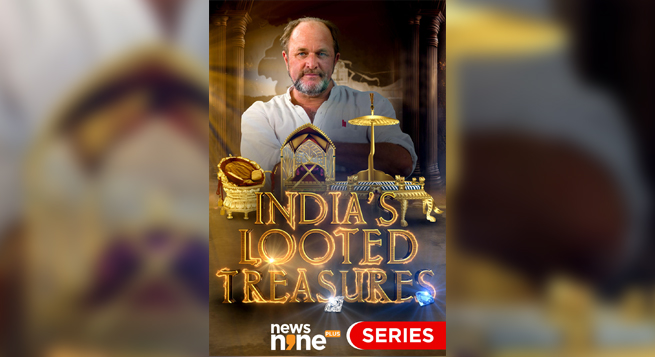News9 Plus launched a new four-part show titled ‘India’s Looted Treasures: Kohinoor to Tipu’s Throne’ that delves into the bloody history of the British plunder of India’s treasures.
Not only the Kohinoor but numerous Indian treasures looted by the British during their nearly two centuries of rule over the Indian subcontinent are housed in British museums.
The series, which includes expert interviews, animated recreations of the looted treasure, and rare archival footage, tells an important story about India’s past and offers solutions to help the country reclaim important aspects of its history, a press release from TV9 Network said.
Among the scholars, historians, and authors featured in the series are William Dalrymple, Anita Anand, Uday Kulkarni and Navtej Sarna.
The series premiere coincides with King Charles III’s coronation on May 6, representing the monarchy that oversaw India’s centuries-long plunder.
The series depicts how the British arrived in India as traders in the 17th century, but quickly became an occupation force, transforming the land into a territory for extracting resources and raw materials, as well as a market for finished goods.
Under British rule, millions of Indians died in wars and famines, and the legacy of their colonization can still be seen today in the looted treasures that remain in museums across the United Kingdom and the United States.
The series, produced by News9 Plus’ team of seasoned editors, consists of four episodes, with each episode delving into the loot of one of the most powerful kingdoms or empires plundered by the British.
The series attempts to answer the location of each item of the loot through interviews with leading historians and experts in the field, including the Kohinoor diamond, which is now part of the British crown jewels, Maharaja Ranjit Singh’s lotus throne, which is on display at the Victoria and Albert Museum and Tipu Sultan’s golden throne, which was broken up but has since resurfaced in an international auction.
Dalrymple describes the plunder as organized loot by the colonizers. “It was a universal understanding in the 18th-19th century that if you surrender, your city is not plundered. But if you put up resistance and are defeated, the morality was that the city could be plundered.
“There is a division of the loot with a quarter of it going to the commander, one quarter to the officers and the rest being divided among common soldiers,” says the historian and the author of the widely acclaimed book “The Anarchy: The Relentless Rise of the East India Company’.
“This is not unique to the British, but as the dominant power in the 18th century, the company is responsible for many examples of loot and plunder. It happens in Shrirangapattnam in 1799, and it happens again in 1857 during the Great Uprising, India’s first war of independence, dubbed ‘India Mutiny’ by the British. And you witness the pillage of Lucknow, Kanpur, and Delhi. And in each of those large sums of wealth and wealth taken by force from the defeated city, the point of the abandoned and it’s a very organized loot,” he adds.
‘India’s Looted Treasures’ provides a unique and insightful perspective on colonialism’s impact on India and its people, as well as the ongoing legacy of this dark period in history. The series is essential viewing for anyone interested in Indian history, culture, and heritage, as well as those seeking to comprehend the ongoing effects of colonialism on the world today.
The four episodes in the series are:
The Loot of Bengal: The defeat of Siraj-ud-Daulah and the capture of Bengal after the Battle of Plassey in 1757 made Robert Clive the richest man in England. Clive remarked how he was ‘astonished at his moderation’. His descendants continue to live off his looted wealth. They own Siraj-ud-Daulah’s palanquin and, in 2004, auctioned off a jade flask for $3 million.
Tipu’s Treasures: The Tiger of Mysore was a thorn in the side of the British. He was killed in combat with the British in 1799. His defeat was followed by the large-scale loot of his treasury, the proceeds of which were taken to Britain.
Treasures of the Maratha Empire: At its zenith in 1760, the Maratha Empire controlled one-third of Indian territory. The defeat of the Peshwa in the third Anglo-Maratha war in 1818 signalled the end of the Empire. The British seized Rs 5 crore in treasure from the Peshwa, but also the fabled Nassack diamond which once adorned the idol of Lord Shiva at the Trimbakeshwar temple in Nashik.
Treasures of the Sikh Empire: The formidable Sikh Empire, welded together by the military brilliance of Maharaja Ranjit Singh, encompassed all of north-western India, Pakistan and parts of Afghanistan. The British did not test the Maharaja in combat, but they moved in on his weaker descendants after his demise. The defeat of the Khalsa Army in 1848 ended the last pocket of resistance against the British. The Kohinoor was ‘gifted’ by Ranjit Singh’s young son to the British. His golden throne was transported to the UK where it remains in the V&A museum.
 Prime Video to limit in India number of TV sets having access per subscription
Prime Video to limit in India number of TV sets having access per subscription  Delhi HC orders meta to remove deepfake videos of Rajat Sharma
Delhi HC orders meta to remove deepfake videos of Rajat Sharma  Govt. blocked 18 OTT platforms for obscene content in 2024
Govt. blocked 18 OTT platforms for obscene content in 2024  Broadcasting industry resists inclusion under Telecom Act
Broadcasting industry resists inclusion under Telecom Act  DTH viewing going down & a hybrid ecosystem evolving: Dish TV CEO
DTH viewing going down & a hybrid ecosystem evolving: Dish TV CEO  Abhishek Singh Rajput shines in ‘Swipe Crime’ on MX Player
Abhishek Singh Rajput shines in ‘Swipe Crime’ on MX Player  Farhan Akhtar’s ‘120 Bahadur’ to hit theatres on November 21, 2025
Farhan Akhtar’s ‘120 Bahadur’ to hit theatres on November 21, 2025  COLORS announces 2025 lineup
COLORS announces 2025 lineup  Sony YAY! announces holiday wishes from Toon-Town this Christmas
Sony YAY! announces holiday wishes from Toon-Town this Christmas  8Bit Creatives partners with ESFI to elevate WAVES esports championship 2025
8Bit Creatives partners with ESFI to elevate WAVES esports championship 2025 








